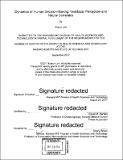| dc.contributor.advisor | Daniel M. Merfeld. | en_US |
| dc.contributor.author | Lim, Koeun | en_US |
| dc.contributor.other | Harvard--MIT Program in Health Sciences and Technology. | en_US |
| dc.date.accessioned | 2018-02-16T20:05:48Z | |
| dc.date.available | 2018-02-16T20:05:48Z | |
| dc.date.copyright | 2017 | en_US |
| dc.date.issued | 2017 | en_US |
| dc.identifier.uri | http://hdl.handle.net/1721.1/113787 | |
| dc.description | Thesis: Ph. D. in Biomedical Engineering, Harvard-MIT Program in Health Sciences and Technology, 2017. | en_US |
| dc.description | Cataloged from PDF version of thesis. | en_US |
| dc.description | Includes bibliographical references (pages 102-110). | en_US |
| dc.description.abstract | When making daily decisions, people naturally ask two questions: how soon can I make a decision, and is it a good decision? In experimental setting, humans can subjectively yet quantitatively assess choice confidence (i.e. how good) based on their perceptual precision even when a decision is made without an immediate reward or feedback. Such choice confidence has been shown to have a non-monotonic relationship with decision time (i.e. how soon), such that choice confidence can be correlated either positively or negatively with decision time depending on how decision time is constrained. However, the neural mechanisms underlying the interaction between choice confidence and decision time during perceptual decision-making are still unclear. Hence, the goals of this research were to (1) develop dynamic computational models and to (2) find neural representations of choice confidence in human scalp potentials. The dynamic models of choice confidence were developed by merging two parallel conceptual frameworks of decision-making, signal detection theory and sequential analyses (i.e., drift diffusion model). Specifically, in order to capture the end-point statistics of binary choice and confidence, we built on a previous study that defined choice confidence in terms of psychophysics derived from signal detection theory. At the same time, we augmented this mathematical model to include accumulator dynamics of a drift-diffusion model to characterize the time-dependence of choice behaviors in a standard forced-choice paradigm. Twelve human subjects performed a subjective visual vertical task, simultaneously reporting binary orientation choice and probabilistic confidence. Both binary choice and confidence experimental data displayed statistics and dynamics consistent with both signal detection theory and evidence accumulation, respectively. Specifically, the computational simulations showed that the unbounded evidence accumulator model fits the confidence data better than the classical bounded model while bounded and unbounded models were indistinguishable for binary choice data. These results suggest that the brain can utilize mechanisms consistent with signal detection theory to assess confidence when observation duration is externally controlled. As a neural mechanism that binds choice action and confidence, a fronto-parietal network has been implicated. Such bi-local neural circuitry is consistent with dual-route model of metacognition, in which the prefrontal cortex supervises and evaluates objectlevel parietal cortex. However, the neural dynamics underlying the interaction between choice confidence and decision time in the fronto-parietal network during the perceptual decision-making have yet to be elucidated. Here we show in fifteen human subjects that choice confidence contributes to frontal event-related potential (ERP) during a predecisional stage when choice accuracy is emphasized over speed during a free response task. We found that the second positive peak, particularly the curvature, of the stimuluslocked frontal ERP at 400-600ms covaries with confidence while the amplitude of the centro-parietal ERP increases with faster decision response time during the same time interval. This finding provides evidence for a causal role of confidence in perceptual decision-making, complementing earlier ERP evidence supporting a retrospective role. Altogether, these results suggest that an internal representation of choice confidence evolves concurrently with choice action prior to reporting a decision. Furthermore, the non-monotonic dynamics of confidence arise from its dual roles that may be determined by the prior expectation of decision time constraint. In other words, the causal role of confidence may underlie the negative correlations between choice confidence and decision time behaviors while the retrospective role may underlie the positive correlations. | en_US |
| dc.description.statementofresponsibility | by Koeun Lim. | en_US |
| dc.format.extent | 110 pages | en_US |
| dc.language.iso | eng | en_US |
| dc.publisher | Massachusetts Institute of Technology | en_US |
| dc.rights | MIT theses are protected by copyright. They may be viewed, downloaded, or printed from this source but further reproduction or distribution in any format is prohibited without written permission. | en_US |
| dc.rights.uri | http://dspace.mit.edu/handle/1721.1/7582 | en_US |
| dc.subject | Harvard--MIT Program in Health Sciences and Technology. | en_US |
| dc.title | Dynamics of human decision-making : vestibular perception and neural correlates | en_US |
| dc.type | Thesis | en_US |
| dc.description.degree | Ph. D. in Biomedical Engineering | en_US |
| dc.contributor.department | Harvard University--MIT Division of Health Sciences and Technology | |
| dc.identifier.oclc | 1022846214 | en_US |
